Art and health, two macro-themes apparently distant from each other, have been combined in this project thanks to the contribution of young students. How have they managed to create a virtuous relationship between the two fields? Through the meeting of the humanistic and scientific worlds made possible by the project “Human Hemispheres: autobiographical narration and care of the professional self”, conceived by Biella’s ASL (local NHS). It is an initiative that resulted in the creation of two new rooms in the new Ospedale degli Infermi in Ponderano (BI), which will host their staff’s training courses and opened on Friday 20th April. But what is worth highlighting is all the work that has gone on behind the scenes of this project. Two subjects are the protagonists: on one hand the students from the Artistic High School Sella in Biella, on the other the employees of the city’s hospital.
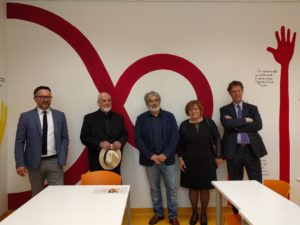
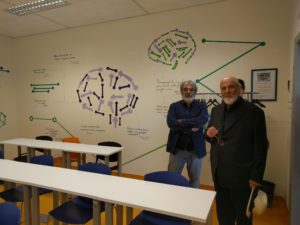
Two classes, led by professors Denise De Rocco and Nadia Landrino, have decorated the walls of the two rooms realizing the artistic proposal of students Marina Barberis and Carlotta Dainese. The subjects depicted are hands, painted by the students in different colours: the first, with special illustrations and in warm colours, represents sensitivity; the second, in cold colours, represents logic and rationality. The idea by the two students was approved by Michelangelo Pistoletto, who chose Marina and Carlotta’s among all the ones submitted. From the individual to the collective: their proposal became the whole class’s, and all their schoolmates have contributed to its realization. The meeting of generations between Pistoletto and the students was made possible by professor De Rocco, who orchestrated the operations in her double role of teacher and Rebirth/Third Paradise ambassadress.
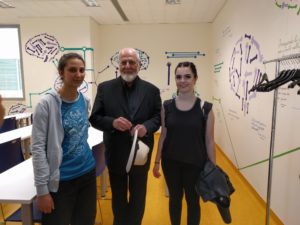
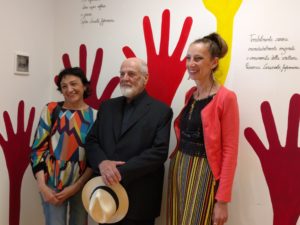
The initiative involved doctors, nurses, operators and administrative personnel, who have left their emotional-artistic mark on the walls. How? Staff participating have told their individual working stories. A lot of narrative flashes that have offered an insight into professional and personal experiences and motives, on the background of the work by the high school students. Here are a few excerpts from this artistic-literary jigsaw puzzle: “My passion for people drives me” (Miriana Miotto, nurse), “A smile welcomes / a word comforts / the soul teaches” (Raffaella Cravero, doctor), “I would have liked to cure people, I take care of paperwork following my dreams” (Eugenia Bordone, administrative assistant).
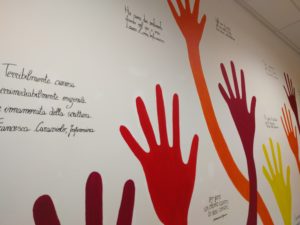
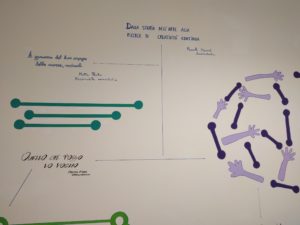
The two rooms, representing two opposites, are connected by the Third Paradise. A reference which is not only a metaphor: the two spaces are actually linked by a representation of Pistoletto’s sign-symbol, drawn in two halves, one in each room. Even the corridor joining the rooms has been specifically furnished, with pictures of images representing Biella’s social and environmental contexts.

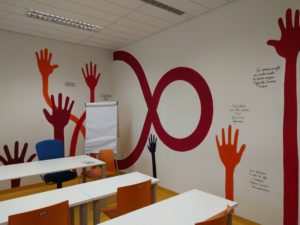
As anticipated, last Friday the two rooms were officially opened (with Michelangelo Pistoletto, ASL general director Gianni Bonelli, the director of Biella’s ASL Training and Human Resources Development department Vincenzo Alastra, the nurse responsible for planning the training courses at Biella’s ASL Training and Human Resources Development department Rosa Introcaso, the headmaster of High School Sella Maria Addolorata Ragone and lawyer Diego Poggio attending) with a presentation of the project in the conference room Elvo Tempia. Bonelli said: “The hospital wants to feature the concept of beauty. The objective is in fact not only to cure illnesses, but also to take care of people and their relatives, to comfort them in the most difficult moments promoting a politics of humanism of care”. ASL general director then thanked Pistoletto and High School Sella for their contribution to the project. The headmaster echoed his words, highlighting the collaboration between the high school and the ASL, professing herself “proud of the students”. At the end of the event, Ragone received a celebratory plaque from the ASL awarding the work of the students in the context of the project and the virtuous collaboration between the two local institutions. Professor Landrino also spoke, explaining the peculiarity of her students’ work and showing satisfaction for their contribution.
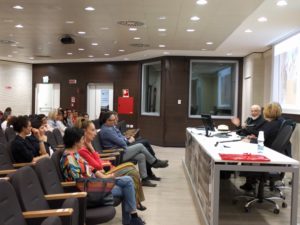
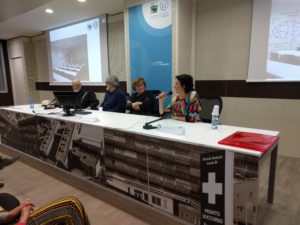
Pistoletto, talking with Alastra and the two girl students, expressed his appreciation for the work of the students too: “The two rooms” – explained the artist – “convey their message at their best, even thanks to the choice of colours. I did perceive a sense of technology/rationality in one room and of emotion/feeling in the other. The hands are a very strong choice. Each hand is individual, but it relates to others to create society”. Pistoletto closed his speech illustrating the peculiarities of the Third Paradise and of trinamics in reference to the project, claiming that: “Beauty is made by the union of reason and sensibility”.
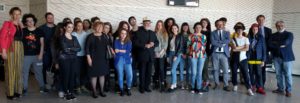
On its Facebook page, Biella’s ATL has shared the reflections of Pistoletto and the students. “Interpersonal connection is the dimension art is able to create connecting people and therefore spreading a warmth that the individual – although an artist – can’t produce on their own. The representations decorating the two rooms with their shapes, colours and meanings are the result of the combination of the skills of the students from Biella’s artistic high school and the professionalism of the hospital staff, everyday committed to their work and development. Art is not in fact an individual act. Creativity fully develops through the connection with the others. The Third Paradise itself is the configuration of the creation, determined by the meeting of two different elements. The raised hands depicted in one of the rooms say “I am here”, “I want to speak” through the vitality of their shapes and colours. The hand becomes word and then – through colour – emotion.”


